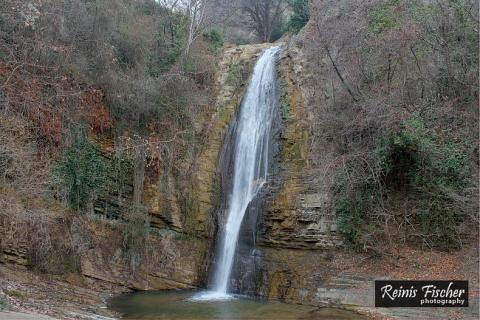Tbilisi Botanical garden is located at the foothills of the Narikala fortress in the city center of Tbilisi. The National Botanical Garden of Georgia occupies the area of 161 hectares and possesses a collection of over 4,500 taxonomic groups.
There are at least to entrances at the garden - one is from the top of Narikala fortress (You can get there by using Aerial tram from Rike Park) and other entrance is from Abanotubani just behind the Tbilisi Mosque.
Entrance fee: 2 GEL (As of 2018). Entrance is free for kids. Annual and six-month subscription is available starting 40 GEL. Probably if I would live in this neighborhood I would make sure I have such a pass.

Aerial photo with Tbilisi canal
If you are not afraid of heights, approach the edge of parking located at the main entrance gates and you will have a spectacular view to Tbilisi canal

Bamboo grove at Tbilisi botanical garden
Gardens history spans more than three centuries. It was first described, in 1671, by the French traveler Jean Chardin as royal gardens which might have been founded at least in 1625 and were variably referred to as "fortress gardens" or "Seidabad gardens" later in history. The gardens appear in the records by Joseph Pitton de Tournefort (1701) and on the Tbilisi map composed by Prince Vakhushti (1735). Pillaged in the Persian invasion of 1795, the garden was revived in the early 19th century and officially established as the Tiflis Botanical Garden in 1845.

Cactus grove
From 1888 on, when a floristics center was set up, Yuri Voronov and several other notable scholars have worked for the Garden. Between 1896 and 1904, the Garden was expanded further westward. Between 1932 and 1958, the territory around the former Muslim cemetery was included in the botanical garden. Several graves have survived, however, including that of the prominent Azerbaijani writer Mirza Fatali Akhundov (1812-1878).

Secret tunnels in park
Ok, they are not secret after all as they are pretty well visible for parks visitors. I always find it interesting - what reason they were built for - like as for some bomb shelters, secret tunnels for government officials or ... the rumor has it - one of the tunnels in park use to be used as the entrance in park, but was closed in mid-2000 as a nightclub was opened in it.
Here is what Wikipedia is saying about it:
The central entrance to the Garden is located at the foothills of the Narikala Fortress. The other, cut through the rock as a long tunnel in 1909-14, had been functional until the mid-2000s when the tunnel was converted into Georgia’s largest nightclub "Gvirabi".
Continuing a little bit of man-made built tunnels in rocks - checkout this Wine Tunnel in the region of Kakheti if your travels take you to these parts of Georgia

Waterfall
Another magic place in Botanical gardens territory is this magical waterfall with a bridge atop of it. You can make a great selfie at least here, I opted for an HDR image instead.

River in Tbilisi Botanical Garden
Park is equipped with children playground, benches and accessible routes, you can spend your day here by hiking or just by relaxing on one of the benches.

Bench in garden
And of course, from gardens territory, you can get spectacular views towards the Narikala fortress

View towards Narikala Fortress
